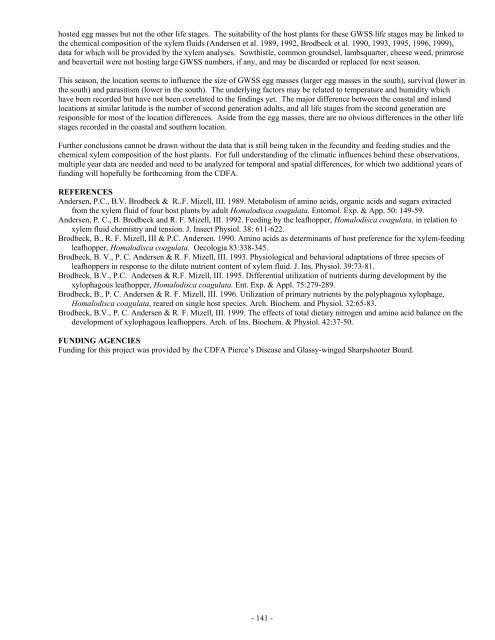Impact Of Host Plant Xylem Fluid On Xylella Fastidiosa Multiplication ...
Impact Of Host Plant Xylem Fluid On Xylella Fastidiosa Multiplication ...
Impact Of Host Plant Xylem Fluid On Xylella Fastidiosa Multiplication ...
You also want an ePaper? Increase the reach of your titles
YUMPU automatically turns print PDFs into web optimized ePapers that Google loves.
hosted egg masses but not the other life stages. The suitability of the host plants for these GWSS life stages may be linked to<br />
the chemical composition of the xylem fluids (Andersen et al. 1989, 1992, Brodbeck et al. 1990, 1993, 1995, 1996, 1999),<br />
data for which will be provided by the xylem analyses. Sowthistle, common groundsel, lambsquarter, cheese weed, primrose<br />
and beavertail were not hosting large GWSS numbers, if any, and may be discarded or replaced for next season.<br />
This season, the location seems to influence the size of GWSS egg masses (larger egg masses in the south), survival (lower in<br />
the south) and parasitism (lower in the south). The underlying factors may be related to temperature and humidity which<br />
have been recorded but have not been correlated to the findings yet. The major difference between the coastal and inland<br />
locations at similar latitude is the number of second generation adults, and all life stages from the second generation are<br />
responsible for most of the location differences. Aside from the egg masses, there are no obvious differences in the other life<br />
stages recorded in the coastal and southern location.<br />
Further conclusions cannot be drawn without the data that is still being taken in the fecundity and feeding studies and the<br />
chemical xylem composition of the host plants. For full understanding of the climatic influences behind these observations,<br />
multiple year data are needed and need to be analyzed for temporal and spatial differences, for which two additional years of<br />
funding will hopefully be forthcoming from the CDFA.<br />
REFERENCES<br />
Andersen, P.C., B.V. Brodbeck & R..F. Mizell, III. 1989. Metabolism of amino acids, organic acids and sugars extracted<br />
from the xylem fluid of four host plants by adult Homalodisca coagulata. Entomol. Exp. & App. 50: 149-59.<br />
Andersen, P. C., B. Brodbeck and R. F. Mizell, III. 1992. Feeding by the leafhopper, Homalodisca coagulata. in relation to<br />
xylem fluid chemistry and tension. J. Insect Physiol. 38: 611-622.<br />
Brodbeck, B., R. F. Mizell, III & P.C. Andersen. 1990. Amino acids as determinants of host preference for the xylem-feeding<br />
leafhopper, Homalodisca coagulata. Oecologia 83:338-345.<br />
Brodbeck, B. V., P. C. Andersen & R. F. Mizell, III. 1993. Physiological and behavioral adaptations of three species of<br />
leafhoppers in response to the dilute nutrient content of xylem fluid. J. Ins. Physiol. 39:73-81.<br />
Brodbeck, B.V., P.C. Andersen & R.F. Mizell, III. 1995. Differential utilization of nutrients during development by the<br />
xylophagous leafhopper, Homalodisca coagulata. Ent. Exp. & Appl. 75:279-289.<br />
Brodbeck, B., P. C. Andersen & R. F. Mizell, III. 1996. Utilization of primary nutrients by the polyphagous xylophage,<br />
Homalodisca coagulata, reared on single host species. Arch. Biochem. and Physiol. 32:65-83.<br />
Brodbeck, B.V., P. C. Andersen & R. F. Mizell, III. 1999. The effects of total dietary nitrogen and amino acid balance on the<br />
development of xylophagous leafhoppers. Arch. of Ins. Biochem. & Physiol. 42:37-50.<br />
FUNDING AGENCIES<br />
Funding for this project was provided by the CDFA Pierce’s Disease and Glassy-winged Sharpshooter Board.<br />
- 141 -











